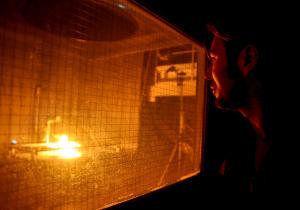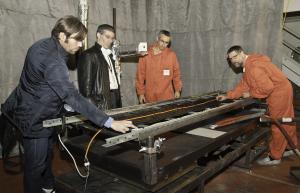They burn cables to prevent fires
3 Feb 2012
-
Robert Arnoux
David Beltran watches as flames devour a set of cables in the SATURNE facility (IRSN) at CEA-Cadarache. Note the small blue lamp in the lower left corner of the image.
Safety is about anticipating aggressions, whatever their nature and their probability. An earthquake, a flood, an airplane crash, a fire breaking out inside the installation—all these are among the events that must be identified, analyzed and simulated prior to the designing of an installation.
Let's take a look at fire, for instance. It is of vital importance to know what material will burn and how fast; how the flames would propagate within an installation; what chemical elements would be released through the smoke; and how these releases would affect the filtration systems, etc.
In ITER, which is mostly concrete and steel, a "fuel of choice" was identified: the large amount of cables that wind and wiggle for dozens of kilometres in the innards of the installation, forming what Electrical Engineer David Beltran calls "the largest mass of combustible material available in ITER."
Not only do cables burn, they may propagate flames and induce other fires. "Cables are long; they run close to each other; they get into every corner of the installation ... In the absence of strong safety measures, they could spread a fire all over the facility," says David.
In order to take these strong measures, one has to know how different cables would behave in the different circumstances a fire would create. "We needed data, as precise as possible, to feed our simulation codes," explains Pierre Cortes, ITER Safety, Analysis and Assessment section leader.
Preparing for the fire testing of a three-metre-long set of different cables. Pierre Cortes is second from left.
All the cables in ITER will be of a particular type called "halogen-free" (or LSZH for Low Smoke Zero Halogen). In case of a fire and subsequent outgassing, they do not produce halogen elements like fluorine, chlorine or bromine that might harm some of the installation's systems.
"Unfortunately, R&D on halogen-free cables is scarce," says Cortes. "The solution was to perform the tests ourselves." And so they did, burning all sorts of cables: thick and thin, long and short, in an upright or lying position, with or without ventilation ...
The data acquired covered issues such as ignition temperature, heat release rate, smoke production, the nature of outgassed elements and the speed of propagation. Tests were conducted throughout the year 2011 in the world-class SATURNE and CARINEA installations (IRSN, Institut de Radioprotection et de Sûreté Nucléaire) where all kinds of different fires can be recreated and their dynamics closely and precisely monitored. Both installations, quite conveniently, are located at CEA-Cadarache.
The tests that were performed also enabled the safety team to test the integrity and functionality of some of the safety-relevant cables under conditions of fire. The experience was both simple and spectacular: an electrical cable, feeding power to a lamp, was slowly devoured by the flames. How long would it hold? How long would the lamp keep shining?
The tests demonstrated that specific cables could retain their functionality—whether they carried power or signal—for quite a long time. Seeing the little light continue to shine as the cable sheath carbonized was an impressive sight indeed ...
Cortes and his team have now accumulated a large amount of data on cable behaviour, type by type, brand by brand, and in all imaginable situations. This is not, however, the end of the story. "The question now is to analyze this data in order to assess whether we should test specific firewall systems or other configurations."
One thing is certain: cables will continue to burn in the dedicated fire-test facilities in Cadarache in order to mitigate the consequences of their potential burning in ITER.



